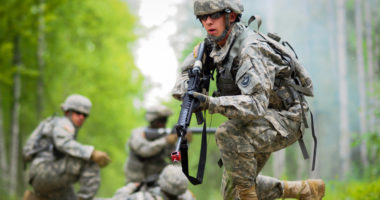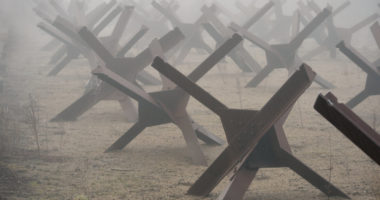The Asia-Pacific region is diverse in religious, ethnic and historical backgrounds as well as in economic development. However, armed conflict is often not recognized by states in the region, and if it is, there is an expectation that they will address such issues internally. The region is also known for having the fewest ratifications of international humanitarian law (IHL) treaties. The Asia-Pacific region is nonetheless home to an active and growing group of academics and practitioners of IHL, which some refer to as “IHL ambassadors”. This group of people can draw on the historical underpinnings of IHL which derive from many traditions and religions still followed today in the region, as well as the understanding of the huge technological advances that are taking place here.
In this post, and in the run-up to the 75th anniversary of the Geneva Conventions later this year, Jonathan Kwik, Ai Kihara-Hunt and Kelisiana Thynne examine the role that academics as “IHL ambassadors” play in the Asia-Pacific region and which they can play elsewhere in promoting, interpreting and developing IHL. They also consider the role that academic journals can play in enhancing the coverage of this important, and often overlooked, task.
The Asia-Pacific region includes some of the great emerging economies of the 20th and 21st century and both the most populous and smallest countries in the world, that not only struggle with economic development, but also with their very existence in the form of encroaching seas. With such diversity and disparities between (and even within) states, the existence of armed conflicts in the region, a majority of which are non-international, is perhaps not surprising. However, quite often, such armed conflicts are not recognized by their government as such, but rather labelled as situations of violence. And for many Asia-Pacific states, the principle of non-interference in the internal affairs of a state is fundamental.
Today, all states are parties to the Geneva Conventions, and almost all states have an active Red Cross or Red Crescent Society. However, international humanitarian law as a legal regime has generally not achieved the same level of integration and recognition here as in some other areas of the world. At the same time, the Asia-Pacific region is characterized by a vibrant community of persons — let’s call them “IHL ambassadors” — who are passionate about the protection and promotion of the laws that govern armed conflicts. They gather academics, legal practitioners and others who wish to protect people from suffering in armed conflicts.
Embracing challenges to the relevance of IHL
An IHL ambassador in the Asia-Pacific region may frequently encounter people who express opposition or indifference to IHL. In a region that is often characterized as one where sovereignty trumps multilateralism, many nationalist voices may consider IHL as an unwanted set of norms that frustrates national defence and security. They may even reject IHL as a ‘Western’ or ‘Christian’ imposition that is fundamentally irreconcilable with their local values. Thus, they sometimes can exhibit reluctance to engage with international norms and drag their feet at signing or ratifying important IHL instruments. Why expend resources for IHL training and sensibilization when one’s country seldom sees war and faces more pressing economic and political concerns? Some actors that are engaging in violence may also insist that their cause for fighting is correct and, therefore, that they should not worry about strictly abiding by IHL rules.
An IHL ambassador should look at these characteristics of the region not with despair, but with optimism. It is precisely these characteristics that provide unique opportunities for engaging with such interlocutors, and also a unique opportunity for the region to contribute to the development of IHL. It is this potential that we wish to highlight through this piece.
IHL in the Asia-Pacific, from tradition to innovation
The Asia-Pacific area is a region of great economic growth and promises, as many of its states lie at the cutting edge of technological development. Cyber, social media-powered cognitive warfare and artificial intelligence are only but a selection of technologies that will undoubtedly impact the future battlefield. The Asia-Pacific stands to play a major role in determining how these technologies will be developed and used. Complementing this promising future potential, however, the Asia-Pacific region can also draw from its rich past. The region is home to a great range of local values, wisdoms and philosophies owing to the long and diverse histories of its peoples. From the laws of armed conflict provided in the Islamic shariah, the Buddhist views on violence, and the ethics of war in the Mahabharata, to the finely detailed rules governing the waging and resolution of conflicts between Moluccan tribes, even the smallest of communities in the Asia-Pacific have engaged with the idea of upholding fundamental humanitarian values while waging wars, far before the advent of ‘modern’ IHL.
An IHL ambassador in the Asia-Pacific, therefore, is in a particular position to draw from both the religious and cultural values of yesterday, and the region’s technological innovations of tomorrow. Such an ambassador thereby stands to highlight the way states can contribute in a unique way to the development of IHL. This role is critical in keeping the relevance of IHL in the changing society, and in bridging the current generation to the next ones, who may be the ones to suffer the consequences of an armed conflict.
Academics as IHL ambassadors
Perhaps to an even greater extent compared to other branches of international law, IHL is a practical regime that developed from humanitarian and military practice, and whose development is still largely formed by treaty and customary law as determined by states. But when we speak of IHL ambassadors, we do not just speak of state representatives who may assist to interpret or develop the law, or military commanders who apply the law. We also mean to address academics and practitioners outside of the traditional government realm of international law, who contribute in promoting, clarifying, developing and enacting IHL. Indeed, academic input is indispensable for IHL’s effective development.
Academics who engage enthusiastically in legal research and publish their findings in academic journals are essential for the development of nuanced, cutting-edge interpretations and applications of IHL. Unlike battalion commanders who are trained in making often quick practical legal decisions in the field, academics have time to reflect on and discuss difficult doctrinal questions. ‘May biometrics be used to improve accuracy in attacks when it also infringes the human right to privacy?’ ‘Under what conditions is a commander criminally liable for harm caused by an AI system they activated?’ ‘If poisoning attacks are used to make AI systems hallucinate and mistake civilians for soldiers, is the system’s owner or the party who poisoned it responsible for the resulting bloodbath?’ Field commanders do not have time to ponder such matters, but would undoubtedly appreciate clear and concrete answers to these questions – so that they can adjust decision-making accordingly. In contrast, academics have theorized extensively on such questions. They are thereby in a position to provide clarity to issues that are fundamental for the conduct of hostilities, but that cannot be answered in the heat of conflict, must be considered beforehand, and must be integrated into the military decision-making process, troop reflexes and behaviour.
There is much precedence of academics having directly contributed to the development of IHL in relation to reacting to new technologies and new realities of warfare. The Tallinn Manual, the Oslo Manual and HPCR Manual are examples of works that efficiently address difficult interpretative questions of IHL related to cyberwarfare, outer space, and artificial intelligence. These manuals were drafted by academics and experts who in their capacity as ‘IHL ambassadors’ contributed to create ‘soft law’ documents. Indeed, some of these documents have, to a certain extent, become authoritative reference materials for a number of states and armed forces. For academics, then, IHL offers many opportunities to act as ambassadors, contribute meaningfully to its development and, to a certain extent, to its enactment by international law actors.
Academics are also often key to fostering a better understanding of IHL, for instance through the lens of religions, explaining the convergence between Islamic law or Buddhist law and IHL. This can lead to improved understanding and compliance with IHL by states and non-state armed groups with a background in those religious traditions. The ICRC’s research on the roots of behaviour and roots of restraint in war has found that an exclusive focus on the law is not as effective at influencing behaviour, compared to a combination of the law and the values underpinning it. Linking the law to local norms and values gives it greater traction.
Of course, all these roles that academics play should be based on two-way communications with states, military entities and practitioners using IHL rules. In this field, the border between academics and practitioners is not always clear. IHL, as interpreted and developed as it can be in the academic realm, aims ultimately at being applied in real operations and actual battlefields to minimize harm. It is thus important that dialogue between academics and practitioners remain open, and that any academic finding also be clarified and made workable for effective use in the field.
A regional gathering of IHL ambassadors
In that respect, regional academic journals or reviews offer valuable fora for IHL ambassadors to discuss and promote ideas on IHL that combine local and international perspectives. For example, the Asia-Pacific Journal on IHL (APJIHL) offers such a space by focusing its authorship on writers from the Asia-Pacific Region or topics about the Asia-Pacific Region. Such journals fill a particular niche that comes with several advantages.
First, such regional journals provide an attractive outlet for articles that explore how IHL is perceived, interpreted and implemented locally. A careful doctrinal analysis of domestic legislation on the protection of child soldiers may be too specific for many international IHL journals, but still be eminently valuable for local stakeholders and policymakers working towards the implementation of IHL at national level. Likewise, such journals provide a perfect space to discuss trends or developing practices in the region, which may not squarely fit with the global ones.
Second, regional IHL journals provide an opportunity for scholars to meld ‘traditional’ IHL analysis with local beliefs, as alluded to above. Not only are these valuable as an inventory of analogies between IHL and old norms, but they also serve a highly useful policy purpose. By framing IHL not as an ‘external’ legal regime that is imposed on a people, but rather as a modern iteration of values that were already engrained within the people’s traditions and values, efforts to enculturate IHL into society and to push IHL-compliant policy and legislation will be facilitated.
Finally, region-specific discussions and research findings can be used for educational purposes with students and people from Asia-Pacific, or with an interest in this region, who are interested in the general field of international law or humanitarianism but have not quite been appealed to IHL yet. Thus, journals such as the APJIHL may also be the best possible avenue to turn interested (future) academics and practitioners into faithful IHL ambassadors, to the benefit of all those likely to be affected by armed conflict.
See also:
- Julie Lefolle, Kay von Mérey, Silvia Gelvez, Elizabeth Rushing, The youth of today, on international humanitarian law tomorrow…, February 1, 2024
- Yasmin Bedir, Omar Mekky, Towards national implementation of IHL: Arab states pledge their commitment, February 15, 2024
- Alistair D. B. Cook, Climate change, environment and humanitarian action in Southeast Asia, March 28, 2023
- Boyd van Dijk, Revisiting the history of the Geneva Conventions, February 17, 2022








Comments